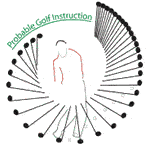Golf Calcuators
Over the years, I've developed a number of different calculators to help people's golf games. Below is a list of those calculators. Click on the links for more information.
Driver Distance Calculator -- input your club speed and this calculator will calculate your carry distance, total distance and angle of launch that maximizes distance. It also plots a graph of the trajectory.
Handicap Calculator -- input your most recent scores, and this calculator will calculate your handicap index.
Golf Altitude Distance Calculator -- input your club carry distances at your home course and this calculator will calculate your distances at other temperatures and altitudes (like 5000 feet compared to Sea Level).
Golf Tournament Draw Calculator -- input the names of your players and this calculator will provide a draw that minimizes the number of times different players play with one another (16 Players in 4 Rounds, etc).
Golf Wind Distance Calculator -- input your distance, wind speed and direction, and this will calculate where to aim and what distance to play (tailwind, headwind, crosswind).
Golf Temperature Distance Calculator -- input your club carry distances at 75 F and this calculator will determine your distances at any other temperature.
Environmental factors can also increase the length of the golfer's drive, however. Golfers will hit it farther when the temperature is warmer (both the air, the club and the ball), when the wind is following (tail wind), when the target is downhill and when altitude is high.
GOLF TIP: During cooler weather, keep your golf balls warm. Start with 3 balls that were in your house overnight (even heat them in a heating blanket). Keep 2 in your trouser pockets to keep them warm. Replace the cold ball with a warm one at the end of the hole. Place the cold one in your pocket to get warmed up again. It won't regain it's original temperature but it will stay warmer than the air and ground. You'll gain a few yards of carry by using warm balls. You can even get a golf ball warmer to keep more balls warm!
The total distance of a drive depends on how far the ball carries in the air and then how far it rolls along the ground. The roll distance is highly dependent on the hardness of the ground and on the trajectory angle of the ball at impact. The steeper the trajectory, the less roll distance. The harder the ground, the greater roll distance.
 |
Average Golfer Swing Speed = 90 mph Carry distance = 195 yd --- Roll distance = 34 yd ---Total = 229 yd PGA Tour Average Swing Speed = 110 mph Carry distance = 267 yd --- Roll distance = 32 yd -- Total = 299 yd The roll distance of the average golfer is 17% of the carry distance while the PGA golfer is only 12% of the carry distance. |
The average golfer gains much more distance in the summer when the fairways
are firm. During the wet season, there isn't much roll.
GOLF TIP:
During the cooler wet season, play the forward tees to shorten the course.
This way, you'll be the same distance from the green as in the summer when
you play longer tees.
A tail wind won't increase the carry
distance much but increase the roll distance for an overall gain. The
greater the wind speed, the greater the gain. However, the higher the wind
speed, the more difficult it is to swing the club.



















